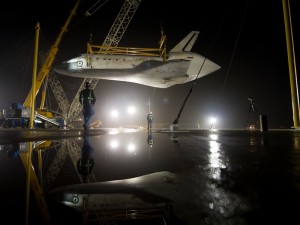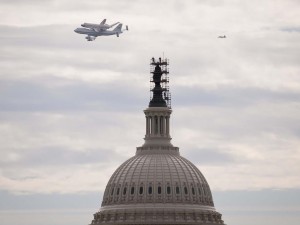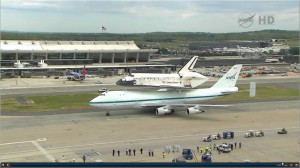
Yuri Gagarin, "I Saw How Beautiful Our Planet Is..."
In addition to a 6′ x 6′ Russian star chart, I bought this poster of Yuri Gagarin during my first trip to the Soviet Union in 1988.[1] It was the tail end of the Cold War, but glasnost’ hadn’t quite taken hold; nobody was quite sure it was safe to talk to the Americans, and for our part, we never used names when talking about Russian acquaintances because of the listening devices embedded in the walls. Although at least one woman from our group ended up marrying a fellow she met in Leningrad, I wasn’t so lucky.[2] Few people were overtly hostile, but I had more than one stranger on the streetcar ask me to explain why Americans hated Russians so much. Why did we want to kill them? I was shocked at the time, but in retrospect, why wouldn’t they think that? Back home, Reagan was doing a good job of threatening to annihilate them.
Our cultural excursions were mostly benign (our leaders dragged us to see the attic garret where Raskolnikov would have lived if he’d been a real person). If the outings were meant to demonstrate the advanced development of the Soviet state, they backfired (really? It’s 1988 and you’re still spitting water and blood into a bucket at the dentist’s office?). There was no clear message that the USSR was winning the Cold War. At the same time, daily life was enveloped in both pro-Soviet and anti-American rhetoric, from the monumental Communist slogans on the top of buildings to the posters in the doctor’s office blaming the spread of AIDS on foreigners. While Kristine and Sergei may have ended up a happy couple, the rest of us weren’t going to be friends. Ever.
And so I spent a lot of time wandering around the streets of Leningrad—Riga—Odessa—Tblisi—Moscow—by myself, looking awkward and suspicious, I’m sure. I bought my star charts and my Gagarin posters and my Soviet Workers Unite! poster (an ironic purchase, to be sure) and my space pins [значки] and my lacquer boxes in all but complete silence. I spoke enough to buy my bread rolls [бублик] and pies [пирожки] on the street, but never so much that you could call it a conversation. When I was in Moscow, I spent all day at the VDNKh space pavilion, hanging around the Lunokhod, but made contact with no one. And it wasn’t just my natural reticence. When I returned two years later, people were still reluctant to speak to foreigners because although it appeared glasnost’ was going to be a long-term government policy, no one could be sure. What if someone spoke frankly to an outsider or to the press? Dramatic policy shift wasn’t exactly an uncommon practice in the Soviet Union.
There’s a point to all this and here it is: if you had told me in 1988 or even 1990 that one day the U.S. would be looking to Russia for transportation to an international space station, or that our governments were actually considering collaborating on space science projects, I would have laughed you out of the room. The U.S. was too overtly hostile to the USSR; the USSR had no working technology outside of the military. Working together? Not possible. I knew what I was talking about—most of my predictions about the Russian future were right on the money. Yet here we are in 2012, on the 51st anniversary of Gagarin’s launch into orbit, and I’m not laughing anymore. It’s not the best of relationships between the two nations, it’s not without problems. But I’m about to post links to a photo history of the Soviet space program, a recording of the radio communications during Gagarin’s launch, and a Soviet documentary about Gagarin (1969), and I can still go to bed without worrying about the NSA showing up on my front porch in the morning. In 1988, I would have stopped to wonder how thick my CIA and KGB files were getting to be. Today, of course, hitting the “publish” button on this post won’t even disturb my sleep.
—————
[1] The words beneath the image were not actually Gagarin’s; rather, they have been attributed to A. Lozenko. It reads, “While I was flying round the Earth in a space-ship [korabl-sputnik], I saw how beautiful our planet is. People, let us preserve and increase this beauty, not destroy it! Gagarin.”
[2] The one woman who hit on me seemed more interested in using me to defect than anything else. At the time, I suspected she was with the KGB because 1) she was persistent in her interest to go to America; and 2) who else would have the guts to walk up to an American woman and express that kind of interest under Soviet rule? In retrospect, I think she was a private citizen who was relieved to see someone else, from somewhere else, who looked like her (i.e. like a 12-year-old boy).









